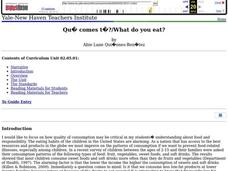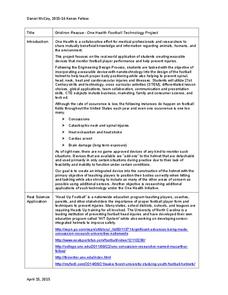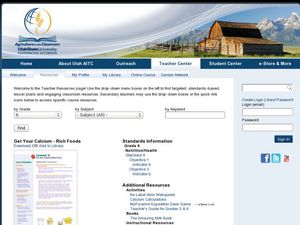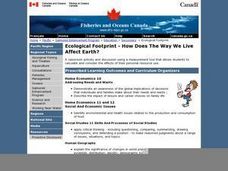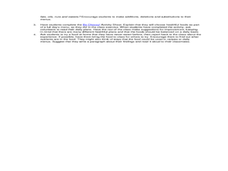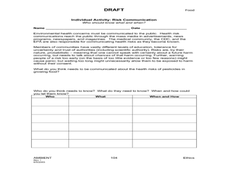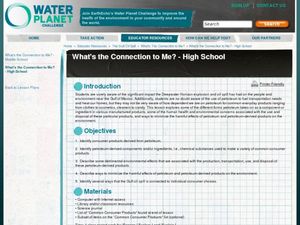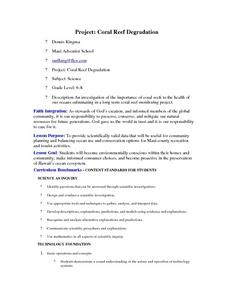Curated OER
Your 4-H Focus on Food Labels
Facilitate healthy eating habits with this collection of activities. This instructional activity, made for 4-H originally, covers nutrition, health, and fitness. Middle schoolers focus on the life skill of making healthy lifestyle...
Carnegie Mellon University
Consumer Preferences in Lighting
What is a watt? This tongue-twisting, mind-bending question and others are answered through this lesson on the different lighting options available. With the support of a PowerPoint, teach your physical science class about units of...
Food Project
Trace The French Fry
How does locally grown produce sold at a farmer's market compare to a more complex industrial system in the way they each affect the environment, people, and the economy? Pupils explore the different types of food systems and how they...
Curated OER
Healthy Snacks. Healthy Packaging
Fourth graders research how to select the most cost-effective snacks. In this consumer practices lesson plan, 4th graders compare packaging labels and come to conclusions on how cost effective the product is. Students discuss their...
Curated OER
Qué comes tú?/What do you eat?
Students make healthy decisions about managing food choices for more nutritious and healthy consumption through this series of lessons.
Curated OER
Agriculture Pays
Second graders role play one of the jobs related to agriculture and explain their role in getting one of the five "f's" of agriculture to the consumer. In this agriculture lesson, 2nd graders are assigned a role and a...
Curated OER
A Day Without Agriculture
Second graders define and create a list of agricultural products. In this producers and consumers lesson, 2nd graders participate in a contest to find as many types of agriculture as they can. The student who comes up with...
Kenan Fellows
Gridiron Rescue: One Health Football Technology Project
Helmets not included! Scholars brainstorm adjustments and sensors to football helmets in an engineering design project to help prevent injuries, such as concussions and spinal injuries.
Curated OER
Get Your Calcium - Rich Foods
Fifth graders explore personal health by identifying positive food choices. In this calcium sources lesson, 5th graders discuss the common ways a human can receive calcium such as consuming dairy products. Students view a virtual tour of...
Curated OER
Save the Earth: It's Everyone's Home!
Young scholars demonstrate how to make earth-smart choices. In this environmental awareness lesson, students listen to a short lecture on environmentally friendly products. Young scholars invent an environmentally friendly product and...
Baylor College
Serving Sizes
Are serving sizes for different foods always appropriate for what you need? In this hands-on activity, learners work in groups to estimate what one serving size of various foods are, and then evaluate their hypotheses by measuring...
Curated OER
Ecological Footprint--How Does The Way We Live Affect Earth?
Young scholars demonstrate an awareness of the global implications of decisions that individuals and families make about their needs and wants. They identify environmental and health issues related to the production and consumption of...
Texas Heart Institute
Nutrition: How Do I Choose the Right Foods?
Young learners discuss how to practice healthy eating habits and the body's need for energy through discussion and exploration of the MyPlate system.
Curated OER
Where's the Beef - Beef Facts or Hype, Is it Bad for You?
Analyze a Happy Meal™ for nutrient content and calories. Blend the contents into "McMush" and use Biuret's solution to test for protein content. There are a few problems with the lesson plan: the resource links are no longer...
Curated OER
Trash...it really piles up!
Students investigate a contemporary "midden" by analyzing trash collected from various sources and determining life-style choices people make. They see that reducing the amount of waste we generate is helpful to the the environment.
Curated OER
Looking at Food Labels
High schoolers interpret the food and nutrition on food labels. They determine their nutrient needs and how comprehending food labels can help them to meet those needs. Pupils recall that food labels provide nutrition information to help...
Curated OER
How Do Foods Help Our Bodies
Students investigate the specific elements found in food that keep us healthy. In this healthy eating lesson, students identify proteins, carbohydrates, minerals, and vitamins as part of a healthy diet when consumed in moderation....
Curated OER
How is Your Food Grown
Students consider how their food is grown due to pesticide use. They reflect on the harm done to the various groups, then discuss the ethical questions from the perspectives of different stakeholders. IN addition, they compile relevant...
Curated OER
Agriculture Counts
Students practice counting. In this early numbers instructional activity, students learn about the beginnings of agriculture and how it ties into math. Students practice counting objects related to agriculture.
Curated OER
What's the Connection to Me?
Students discuss the impact of oil spill to the environment and to their daily lives. In this environmental science lesson, students research the pros and cons of petroleum based products. They share their findings in class.
Curated OER
Coarl Reef Degradation
Students explore methods of preserving Hawaii's ocean ecosystem. Using underwater cameras, students take pictures of the underwater reef. They perform activities to determine the history and degradation of the coal reef. While...
Curated OER
A Feast for the Future
Students participate in an activity that uses a simulated meal of transgenic foods in order to initiate a discussion of the controversy concerning the use of transgenic food products.
Curated OER
People and the Ocean
Students view a demonstration of the ocean and what we can do to help it, and also identify seafood items that students would order on a menu. In this ocean lesson plan, students learn how people are connected to the ocean and how we can...
Curated OER
Bucket Brigade
Young scholars participate in a physical fitness activity about water. In this water conservation lesson, students discuss how to conserve water and the amount of water most people use in a day. To illustrate this amount young scholars...






